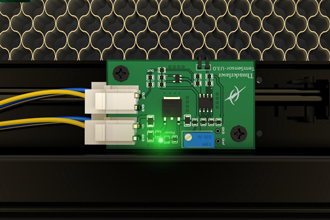Laser is especially suitable for material processing because of its excellent monochromaticity, coherence and directional collimation. Laser processing is the most promising field of laser application. Now more than 20 laser processing technologies have been developed.
The space and time control of laser is very good, and it has great freedom to the material, shape, size and processing environment of the processing object, especially suitable for automatic processing. The combination of laser processing system and computer numerical control technology can form efficient automatic processing equipment, which has become the key technology for enterprises to implement timely production, and has opened up a broad prospect for high-quality, efficient and low-cost processing and production.
Laser rapid prototyping technology integrates the latest achievements of laser technology, CAD / CAM technology and material technology. According to the CAD model of parts, photosensitive polymer materials are solidified layer by layer with laser beam and accurately stacked into samples. Complex parts can be quickly and accurately manufactured without mold and cutter. This technology has been widely used in aerospace, electronics, automobile and other industrial fields. Laser cutting technology is widely used in the processing of metal and non-metal materials, which can greatly reduce the processing time, reduce the processing cost and improve the quality of the workpiece. Pulsed laser is suitable for metal materials, continuous laser is suitable for non-metal materials, the latter is an important application field of laser cutting technology. Laser welding technology has the effect of bath purification and can purify the weld metal, which is suitable for welding between the same and different metal materials.
Laser welding has high energy density, which is especially beneficial to metal welding with high melting point, high reflectivity, high thermal conductivity and great difference in physical properties. Laser welding uses a lower power laser beam than when cutting metal to melt the material without vaporizing it. After cooling, it becomes a continuous solid structure. Laser drilling technology has many advantages, such as high precision, strong universality, high efficiency, low cost and significant comprehensive technical and economic benefits. It has become one of the key technologies in the field of modern manufacturing.
Before the laser appeared, only the material with higher hardness can be used to drill holes on the material with lower hardness. In this way, it is extremely difficult to drill holes in the diamond with the highest hardness. After the emergence of laser, this kind of operation is fast and safe.
Laser marking technology is one of the biggest application fields of laser processing. Laser marking is a kind of marking method, which uses high energy density laser to irradiate the workpiece locally to vaporize or change the color of the surface material.
Laser marking can produce a variety of characters, symbols and patterns, and the size of characters can range from millimeter to micron, which has a special significance for the anti-counterfeiting of products. All solid state ultraviolet laser marking is a new technology developed in recent years. It is especially suitable for metal marking and can realize submicron marking. It has been widely used in microelectronic industry and bioengineering.
Laser debalancing technology is a process of using laser to remove the unbalanced part on the high-speed rotating parts and make the inertia axis coincide with the rotating axis to achieve dynamic balance. Laser debalancing technology has two functions of measurement and debalancing. It can measure and correct the unbalance at the same time. The efficiency is greatly improved. It has a broad application prospect in the field of gyro manufacturing. For high-precision rotors, laser dynamic balancing can double the balancing accuracy, and the balancing accuracy of mass eccentricity can reach 1% or a few thousandths of a micron.
Compared with the traditional chemical etching technology, the laser etching technology has the advantages of simpler process, lower production cost, and can process 0.15-1 micron wide lines, which is very suitable for the manufacture of VLSI.
Laser trimming technology can automatically fine tune the resistance, and the precision can reach 0.01% ~ 0.002%, which is higher than the traditional processing method in precision, efficiency and cost. Laser trimming includes thin film resistor (0.01-0.6 μ m thick) and thick film resistor (20-50 μ m thick), capacitance trimming and hybrid IC trimming. Laser storage technology is a kind of technology that uses laser to record video, audio, text data and computer information (such as CD, DVD, etc.), which is one of the supporting technologies in the information age.






